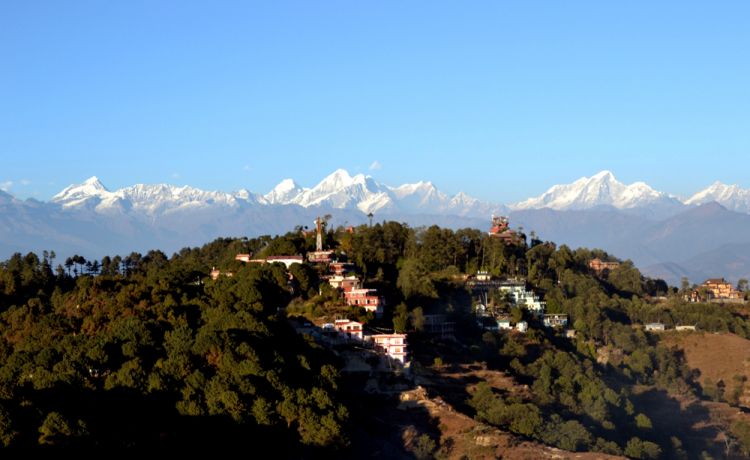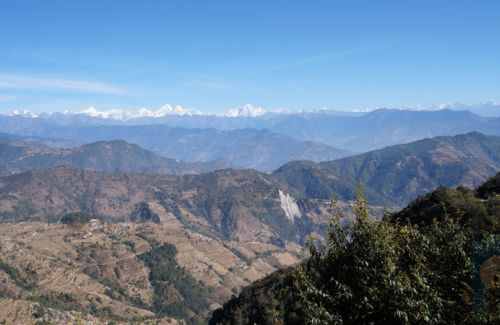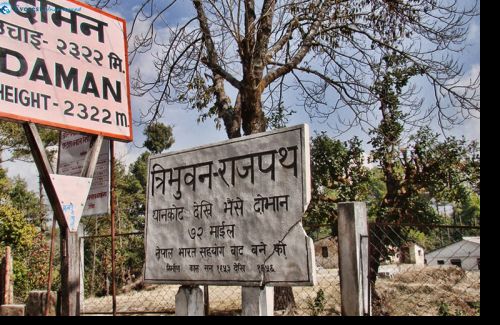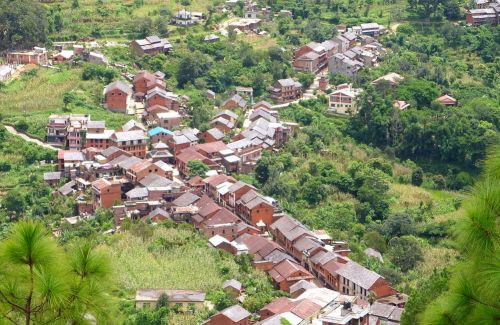Nagarkot Tour
- Duration05 Days
- Max. Altitude2,175 m
Destination:Nepal
Trip Grade:Easy/Mild (*)
Meals:Breakfast
Transportation:Private Vehicle
Accommodation:Hotel
Trip Route:Kathmandu – Nagarkot – Bhaktapur - Kathmandu
Show All
This is the city of fort. It is 2175 m, high from the sea level. It is 32 km far from Kathmandu. It takes 1 and half an hour to be there. Nagarkot is very much one nightstand. From Nagarkot, there lies Chisapani in the north, Banepa in the south, Indrawati River in the east and Sankhu, Sundarijal, Changunarayan in the west. There is a Mahakali temple few meters far from the bus park on the little hill and the other landmark of this vicinity is the little cheese making Project. We can view 300km. mountain ranges especially Dhaulagiri in the west and Mt. Everest/ Kanchanjungha in the east. Besides this we can see other mountains like Ganesh Himal (7406m.), Langtang Lirung (7246m.),Shisha Pangma (8012m.),Dorje Lakpa (6975m.) and Gaurishankar (7146m.).
This place is quiet retreat from the hustle and bustle of the city. Nagarkot is famous for the sun rise and the sun set. In many of the lodges in Nagarkot, rooms are situated to look directly out into the mountain range so that views are available without even opening a door. For those wishing to stretch their legs and enjoy the fresh morning air, there are charming walking trails as well as a lookout tower from which the sights can be taken in. Nagarkot was originally developed as an army post. Hiking and Mountain biking routes up and back down are particularly worthwhile.
Trip Highlights
- Nagarkot was the fort in the past – where there is military camp now
- It was the trade route from Tibet
- Rana rulers’ summer holiday destination
- Great vantage point for 300 km long mountain range from Manaslu to Kanchanjungha
- Honeymooner’s paradise
- Wonderful Natural landscape
Day to Day Itinerary
Day 01:Arrival in Kathmandu (1,350 m) and Transfer to the hotel
Day 02:Sightseeing of World Heritage sites in Kathmandu valley
Day 03:Drive from Kathmandu to Nagarkot (2,175 m), 1.5 hrs. Overnight stay at hotel
Day 04:Sightseeing around Bhaktapur, and drive back to Kathmandu. Overnight stay at hotel
Day 05:Transfer to the Airport
Cost Include
- Airport picks up and drops off
- Entrance Fees of all Historical Sites
- Government Licensed holder English speaking tour guide
- Private Transportation during the Tour
- Hotel ( with Breakfast) as per your choice in Kathmandu and Nagarkot
- All the government tax, VAT and service charges
Cost Exclude
- Personal Expenses of your own
- Lunch and Dinner in Kathmandu and Nagarkot
- Tips for the Guide/Driver
- Any other expenses which are not in ‘Cost Includes’ Section
Detail Itinerary
Day 01Arrival in Kathmandu (1,350 m) and Transfer to the hotelUpon your arrival at Tribhuvan International airport, Kathmandu, our representative from Himkala Adventure greets you heartily and transfers to hotel. After check in hotel, you could get refreshed and take rest for a while. You could explore Thamel, the modern touristy shops, the blending of ethnic stuffs, garment textiles and curio shops, good smell from the restaurants, breathtaking architecture, stunning pageantry, and history so alive, you find the dark alleys, vendors and sacred cows on the street. Overnight at Kathmandu
Day 02Sightseeing of World Heritage sites in Kathmandu valley After breakfast, we get ready for the day tour in UNESCO World Heritage Sites. We begin our tour from Swoyambhunath Stupa, lovingly called it ‘Monkey Temple’, perched in conical shaped hill, 77 m high from the ground floor. The site of Swoyambhu Mahachaitya is the cradle of Bajrayana Buddhism, a traditional unique to Kathmandu Valley. Bajrayana is a tantric variation of the Mahayana (the larger vehicle) Tradition. This place is the spiritual house of all the Buddhas and the Bodhisattvas symbolized by the five Dhyani Buddhas: Aksobya in the East, Ratnasambhava in the South, Amitabha in the West, AmoghaSiddhi in the North and Vairochana in the Center.Shatikat Acharya, the great tantric has built a temple for each of the five elements wind, earth, fire, water and sky. The hemispherical garba is made of brick and stone. Tibetan believers pour lime down the chaitya as a ritual to cure illnesses of family members. The magnificent temple on the western side of the dome is Harati temple, dedicated to mother protrectress known as Shitala for Hindus and Ajima for Newari and Harati for Buddhists, attracts worshippers for the protection of children against diseases. After this we drive 2 and half kilometers to Kathmandu Durbar Square. The Durbar Square is actually made up of two sub areas. The outer complex is renowned for numerous interesting temples as Kumari Ghar, Kasthamandap, Shiva-Parvati Temple, Jagannath Temple, and Big Bell etc. while the inner complex comprises the old palace area, Hanuman Dhoka and its courtyards as Nasal Chowk, Mul Chowk, Sundari Chowk, Lohan Chowk, Mohan Chowk, Basantapur Durbar and others. Besides the magnificent temples and shrines, other interesting aspects are various festivals, cultural activities and traditions people are following from centuries. The mystical charm of the Durbar Square allures the visitors to spend hours wondering around the area.The sites is being renovated after the massive earthquake – 2015. Another place, after 6 km drive is Boudhanath stupa, one of the greatest stupas in the world. This has been partially damaged by the earthquake and now under restoration. The splendid dome of Boudha Stupa is approximately 120 ft in diameter, 1 hector in width and 43.25 m in height. It is known as Jyarung Khashyor. This stupa is religiously, culturally and archeologically very important. It has become the center of a thriving town of monasteries, craftsmanship, and businesses. It is believed that those who reside around this great stupa will never have to suffer from the hunger, famine and unfavorable conditions. The other important sites around Boudha Stupa are Ajima Temple, Guru Lhakhang Monastery, Samteling Monastery, Jhamchen Lhakhang and Palri Tahsi Migyur Dorje Gyaltsen Ling etc. There are more than 28 monasteries around this area. The fourth place we visit is Pashupatinath Temple, Shiva temple, described Him as Lord of the entire living beings and the source of eternal bliss and peace. Pashupatinath Temple is the holiest temples of the world revered and worshipped both by Hindus and Buddhists. We can see the cremation ghat, ritual bathers, priests performing ritual activities, and the sadhus lying smearing ashes in their bodies half naked. Since time immemorial, the Pashupati Area has been a place of prayer and worship for freedom from worldly bondage as well as a place of meditation to realize oneself as part of the Supreme Self. We can see the main Shiva Temple with its golden roof and silver doors, the Basuki Naga Temple, Shivalayas with phallic idols, other temples dedicated to Rama and Vishnu, the temple dedicated to mother goddess Parvati etc. After the sightseeing, we return back to hotel. Overnight at Kathmandu
Day 03Drive from Kathmandu to Nagarkot (2,175 m), 1.5 hrs. Overnight stay at hotel After breakfast, we drive from Kathmandu to Nagarkot. It is 32 km east from Kathmandu, 1 hour 30 minutes drive by car. It is situated at an altitude of 2,175 m, a popular tourist resort of Nepal. Nagarkot means ‘The city of Forts’. Nagarkot was originaly developed as an army post. Tourist facilities came late, with government encouragement. Nagarkot is famous for sunrise, sunset and 300 km long mountains ranges from Manaslu in the west to Everest in the east. In many of the lodges in Nagarkot, rooms are situated to look directly out into the mountain range. If we would like to stretch our legs and enjoy the fresh morning air, there is charming walking trails as well as a lookout tower from which the sights can be taken in. We can visit two landmarks in this vicinity are a tiny Mahakal Shrine and a small scale Cheese making project. Overnight at Nagarkot
Day 04Sightseeing around Bhaktapur, and drive back to Kathmandu. Overnight stay at hotel After breakfast, we drive down to Bhaktapur which is 20 km from Nagarkot. Bhaktapur is an ancient town known by its other names like Bhadgoan, Khwopa. Bhaktapur literally means the city of devotees. Amshuverma developed this city as the trade center. In Mall period, the city was developed as the capital of Nepal and it was called Tripura. At present there are seven chowks: Mulchowk, Bhairav Chowk, Ita Chowk, Malati Chowk, Siddhi Chowk and Kumari Chowk. The cobblestone streets link a string of temples, courtyards and monumental squares, and the side streets are peppered with shrines, wells, and water tanks. We visit Dattatraya Square, Taumadhi Square, Pottery Square and Durbar Square. Dattatraya is a unique architecture brought from Orangabad from India. The temple is dedicated to trinity of Hindu gods like Brahma, Vishnu and Maheshwor. Pujari Math attracts with its wonderfully carved wooden windows, especially the peacock windows. The Nyatpola Temple and Bhairav temples reveal the best medieval art and craftsmanship. The stairway at Nyatapola leading to the temple is lined with pairs of figures and human beings identified as powerful wrestlers, elephants, lions, griffins and goddesses. Pottery Square shows the local peoples’ engagement and dedication in the traditional occupation. Durbar Square is famous for the typical Newari architecture with various cultural and religious values. The 55 windows palace, Golden Gate, Mul Chowk, and Kumari Chowk are the greatest model of art and craft in the Kathmandu Valley. After the sightseeing of this place, we drive back to Kathmandu. Overnight at Kathmandu
Day 05Transfer to the Airport The Hill Resort tour to Nagarkot ends today with lot more memories of countryside and the panoramic views. We depart you to the airport 3 hours before your flight. If you have time for shopping, we can help you visit the local market and buy some dainty gifts to your families, friends, and relatives. Finally, we escort you to the airport and say bye and wish you have safe and happy journey. Namaste!!!








